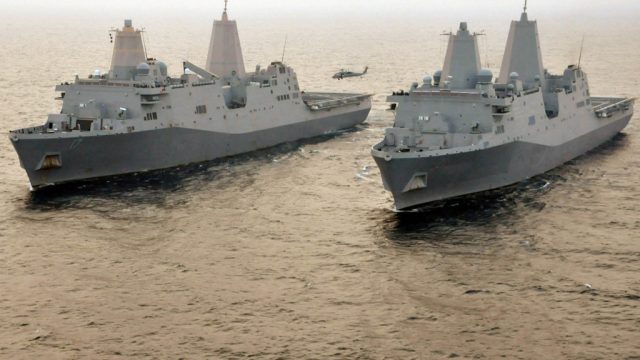Navy shipbuilding crisis has far-reaching consequences

IN FORMATION: Production of the San Antonio class amphibious ships has shifted to Ingalls’ Pascagoula, Miss. shipyard from the now-closed Avondale yard in Louisiana.
By Steve Wilson | Mississippi Watchdog
The U.S. Navy’s shipbuilding crisis is demonstrating far-reaching effects on the nation’s economy and foreign policy goals.
Take, for example, Ingalls’ recently closed composite-construction yard in Gulfport. First, the Coast Guard passed on composite deckhouses for its new class of fast-response cutters, going to a different design. When the Navy decided to transition from a composite deckhouse like on the first two Zumwalt-class destroyers to a steel one constructed at Bath Iron Works, that proved the knockout blow.
The yard closed in July, putting 400 shipbuilders out of work, according to local TV station WLOX. The decision was announced last year and shows the impacts of poor procurement decisions on local communities and their economies.
The Navy’s 30-year shipbuilding plan is desperately short of funds. The lost decade of the 2000s — when several ship designs proved to be peppered with cost overruns like the Littoral Combat Ships and Zumwalt class destroyers and turned out to be better in Power Point than when steel was cut — will be to blame. The stated Navy goal of a fleet of 306 ships is in serious jeopardy.
“If the CBO and CRS are correct, and if Navy’s projected costs prove to be lower in the event, the U.S. fleet will not reach the current goal of 306 ships,” said Seth Cropsey, former deputy undersecretary of the Navy in the Reagan administration and author of “Mayday: The Decline of American Naval Supremacy.”
With China expanding its fleet and influence, a hollowed-out U.S. Navy will not be able to act as the sharp end of the Obama administration’s “Pacific Pivot,” a shift of forces and emphasis from the Atlantic area.
In a time when the world is more dangerous, critics argue the fleet should be growing, not shrinking. But thanks to the sequester and short-sighted procurement decisions that wasted time and valuable dollars in the late 1990s and early 2000s, the fleet’s status is in doubt.
“The world is becoming a more dangerous place, generally, and specifically for untrammeled transit through the sea and air international commons,” Cropsey said. “Piracy breaks out off the Horn of Africa and is controlled only to reappear off the West Africa coast. China carves out large sections of international waters and claims the area as a critical interest. Russia stations a dozen ships in the Eastern Med and the U.S. Sixth Fleet is a flickering shadow of its former strength in the region.”
Heavily dependent on Navy contracts, the U.S. shipbuilding industry has waxed and waned with budget fluctuations with serious economic repercussions for nearby communities.
When the Navy was hit hard with the post-Gulf War “peace dividend” in the early 1990s, it didn’t order as many ships and the number of yards winnowed away.
Navy-owned shipyards in Philadelphia and New York, among others, were closed by the Base Realignment and Closure Committee. The Avondale yard in New Orleans, which had built amphibious ships and Coast Guard cutters, closed in 2013.
The privately owned shipyards shrank to two capable of building large surface warships — Ingalls in Pascagoula and Bath Iron Works in Bath, Maine. There were two shipyards capable of building nuclear submarines — Electric Boat in Groton, Conn. and Newport News in Virginia, the latter also building nuclear-powered aircraft carriers.
But the news isn’t all grim.
Congress is trying to find money in the Navy’s budget to prevent the premature retirement of the aircraft carrier U.S.S. George Washington (CVN-73) and approved $50 million to start defueling the ship’s nuclear core, the first step in the mid-life update that will likely cost $7 billion. If the Navy has to retire the Washington, it will drop below the legally mandated 11 carriers.
The Virginia class fast-attack submarines, built jointly by Electric Boat and Newport News, are coming in under budget, with the Navy and the builders shaving $400 million off the cost of each boat.
The Navy has said it needs 38 amphibious assault ships designed to carry Marines and equipment for amphibious landings, but now only has 28. Mississippi’s Senate delegation was able to secure partial funding — $800 million of the ship’s approximate $1.9 billion cost — for a 12th San Antonio class landing platform dock built at Ingalls. This class is replacing ships more than 30 years old. Ingalls also builds the America class assault ship, which carries helicopters and Marines and can be rerolled as a light carrier with AV-8B Harrier II strike planes.
“The Navy and Marine Corps desperately need ships. We all know this,” said Ryan Taylor, communications director for U.S. Sen. Roger Wicker. “It doesn’t get us close to where we need to be, but little by little, we’re making sure they can get new ships to replace the older ones that are being decommissioned.”
Cropsey thinks the nation’s defense priorities need to be shifted to fit the needs of the “Pacific Pivot.” In the Pacific theater of World War II, Navy carrier task forces and amphibious ships were the primary means to bring war to Japan. Any conflict in the area would require a similar strategy.
“With a few exceptions the Defense Department hews to its roughly equal division of resources among the military services,” Cropsey said. “This fails to acknowledge American seapower’s vital strategic peacetime role in sea control, deterring conflict, projecting power and assuring our allies.”
Get regular updates on Mississippi through our Facebook or Twitter accounts







